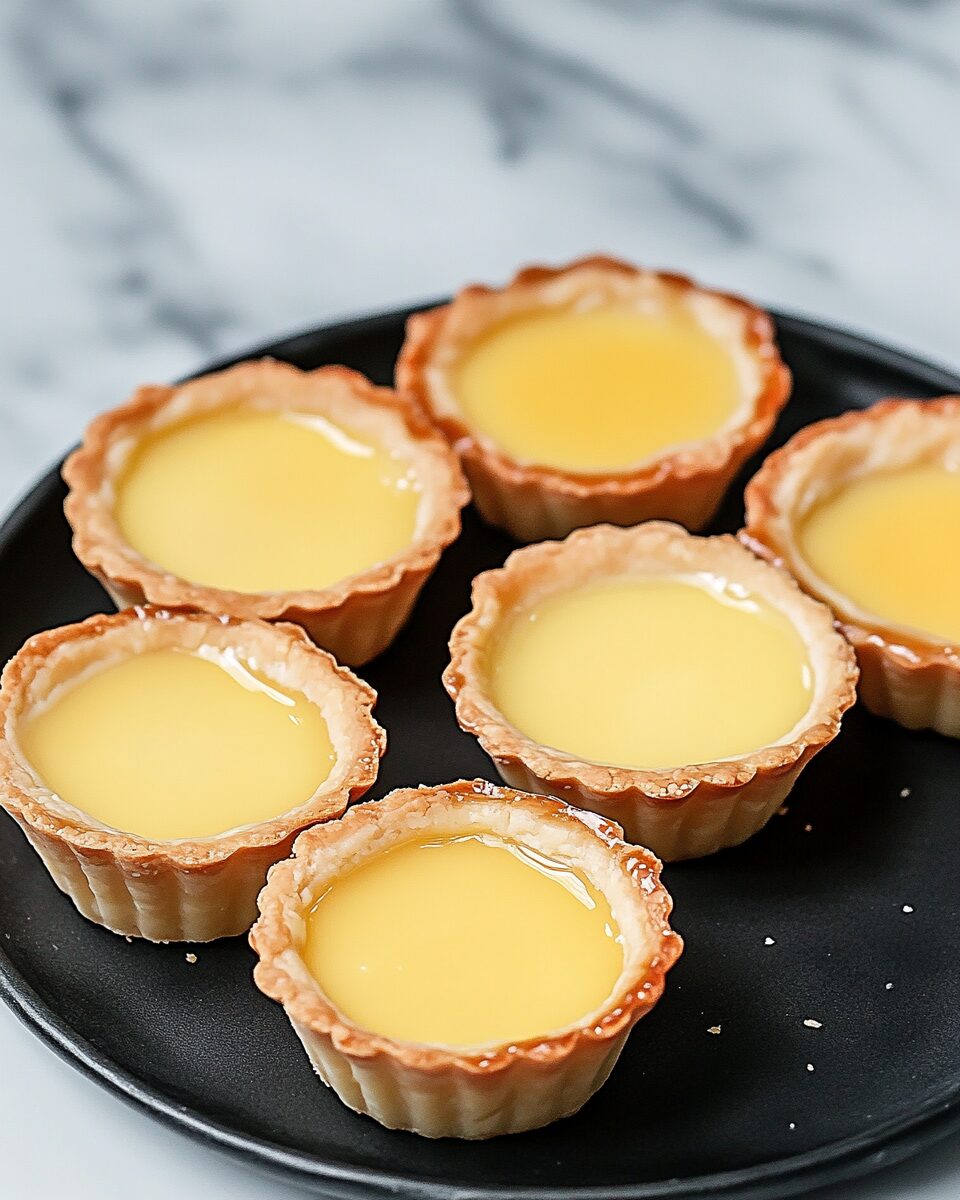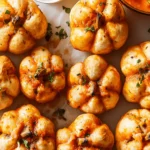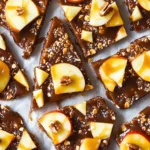These creamy Chinese egg tarts feature a silky custard filling nestled in a flaky, buttery shell. A popular treat in Chinese bakeries, they balance sweetness and richness with a delicate texture, perfect for dessert or a mid-day snack.
FULL RECIPE
Ingredients
- 1 cup all-purpose flour
- 1/2 cup unsalted butter, cold and cubed
- 2 tablespoons powdered sugar
- 1–2 tablespoons cold water
- 3 large eggs
- 1/2 cup granulated sugar
- 3/4 cup whole milk
- 1/2 cup heavy cream
- 1 teaspoon vanilla extract
Directions
- Preheat oven to 375°F (190°C).
- In a mixing bowl, combine flour and powdered sugar. Cut in cold butter until mixture resembles coarse crumbs.
- Add cold water a tablespoon at a time until dough forms. Do not overwork.
- Roll out dough and cut circles to fit a standard muffin or tart tin. Press dough into cups and chill for 15 minutes.
- In another bowl, whisk eggs and granulated sugar until smooth.
- Stir in milk, cream, and vanilla extract until well combined.
- Strain custard through a sieve to remove bubbles or solids.
- Pour the filling into the prepared tart shells, about 3/4 full.
- Bake for 20–25 minutes until custard is just set and lightly golden on top.
- Cool tarts in the tin for 10 minutes, then remove and serve warm or at room temperature.
Nutritional Information
- Calories: 190 per tart
- Fat: 12g
- Saturated Fat: 7g
- Carbohydrates: 17g
- Sugar: 10g
- Protein: 3g
- Fiber: 0.3g
Cultural Significance of Chinese Egg Tarts
Chinese egg tarts are more than just a dessert—they’re a cultural icon that represents the fusion of East and West. Originating from the influence of British custard tarts and Portuguese pastel de nata, they evolved into a beloved bakery item across Hong Kong, Macau, and Chinatowns worldwide. These pastries are often found in dim sum restaurants, highlighting their integral role in traditional Chinese dining customs.
Regional Variations
Although widely recognized in their Hong Kong-style form, Chinese egg tarts differ regionally. Macau’s version often incorporates a caramelized top and is slightly denser, owing to Portuguese influence. Hong Kong’s tarts tend to be lighter with a smoother texture. Each variation tells a story about colonial history and culinary adaptation.
Texture and Flavor Profile
The hallmark of a great Chinese egg tart lies in its balance of textures and flavors. The pastry crust should be flaky and slightly crisp, contrasting with the creamy, custardy filling. The flavor is subtle, mildly sweet, with hints of vanilla and a rich egg aroma that doesn’t overwhelm the palate.
Baking Tips for Perfect Results
For the perfect tart, keeping ingredients cold is key when making the crust to ensure flakiness. Straining the egg mixture removes bubbles and produces a smoother custard. Avoid overbaking, as the custard should jiggle slightly when done and set as it cools. A golden top with no cracks indicates proper baking.
Serving Suggestions
Chinese egg tarts are best enjoyed warm or at room temperature. They pair wonderfully with a cup of jasmine or oolong tea. While they are often eaten plain, some people enjoy a light dusting of powdered sugar for an added touch of sweetness. They can also be served as part of a larger dessert spread during special occasions.
Storage and Shelf Life
Egg tarts are best consumed fresh, ideally within the day of baking. However, they can be stored in an airtight container in the refrigerator for up to 3 days. To enjoy them warm again, a few minutes in a toaster oven will revive the crispness of the crust and the creaminess of the filling.
Freezing and Reheating
Although not traditionally frozen, egg tarts can be wrapped tightly and frozen for up to one month. Reheat them in a preheated oven rather than the microwave to maintain their texture. Allow them to thaw slightly before baking at 350°F until warmed through.
Common Mistakes to Avoid
Overmixing the custard can introduce too much air, leading to bubbles or cracks during baking. Using low-fat dairy can compromise the richness of the filling. Underbaking or overbaking both affect texture—too little time results in a runny center, while too much leads to a rubbery consistency.
Health Considerations
While indulgent, egg tarts can be adapted for dietary preferences. Using reduced sugar, plant-based milk, or gluten-free crust alternatives makes them accessible to more people. However, they remain a treat rather than an everyday snack due to their high butter and egg content.
Historical Background
The Chinese egg tart as we know it today began to gain popularity in the 1940s and 50s in Hong Kong. Influenced by both British and Portuguese baking traditions, local chefs tailored the recipe to suit Cantonese palates. Its popularity grew as it became a staple in Hong Kong bakeries and tea houses.
Popularity in Modern Cuisine
Egg tarts have experienced a resurgence thanks to social media and the global interest in Asian cuisine. Many bakeries now offer variations like matcha, chocolate, or even durian-flavored tarts. Chefs have modernized them with artistic designs, drawing new audiences while respecting traditional methods.
Pairing with Beverages
The delicate sweetness and creamy texture of egg tarts make them an ideal companion for tea, especially floral and green varieties. Coffee, particularly espresso or cappuccino, provides a bold contrast. Dessert wines like Moscato can also complement their richness.
Perfect for Celebrations
Egg tarts are commonly served during Lunar New Year, weddings, and family gatherings. Their golden appearance symbolizes prosperity and joy, making them a meaningful addition to festive tables. Gifting egg tarts is also a sign of respect and goodwill in many Chinese communities.
Child-Friendly Treat
Due to their mild flavor and soft texture, egg tarts are well-loved by children. They serve as a great introduction to Asian flavors for young eaters. Their size and hand-held form also make them easy to serve at parties or school events.
Vegan and Dairy-Free Alternatives
For those avoiding animal products, tofu, coconut milk, or plant-based cream can substitute the traditional custard base. Vegan butter or shortening can replace dairy in the crust. While these adjustments alter the taste slightly, they can still create a satisfying version of the classic.
Crust Options
While puff pastry is common, shortcrust pastry offers a more crumbly and buttery texture. Some home bakers opt for cookie-style crusts, which give a sweeter, firmer base. Each crust type changes the mouthfeel and should be matched to the desired final product.
Customization and Creativity
Modern bakers experiment with ingredients by adding citrus zest, flavored syrups, or even edible flowers to elevate the traditional tart. Mini versions, tartlets, or large-format versions for slicing are also popular variations. This allows egg tarts to adapt across cuisines and preferences.
Nutritional Breakdown
On average, one egg tart contains about 190 calories, with a fair amount of fat and sugar. While they provide some protein from eggs, they’re not nutrient-dense. They are best enjoyed occasionally and balanced with lighter meals throughout the day.
Baking Tools and Equipment
To achieve professional-quality egg tarts, a tart tin with smooth edges is ideal. A rolling pin for the dough, a sieve for straining the custard, and an oven thermometer ensure precision. Non-stick muffin tins also work in a pinch for those without specialized equipment.
Conclusion
Chinese egg tarts combine heritage, flavor, and texture into a compact, delicious treat. Their enduring popularity across generations and countries showcases their universal appeal. Whether served at a festive gathering or enjoyed solo with tea, they remain a nostalgic and satisfying dessert. With endless ways to customize and adapt them, egg tarts continue to evolve while staying rooted in culinary tradition.






